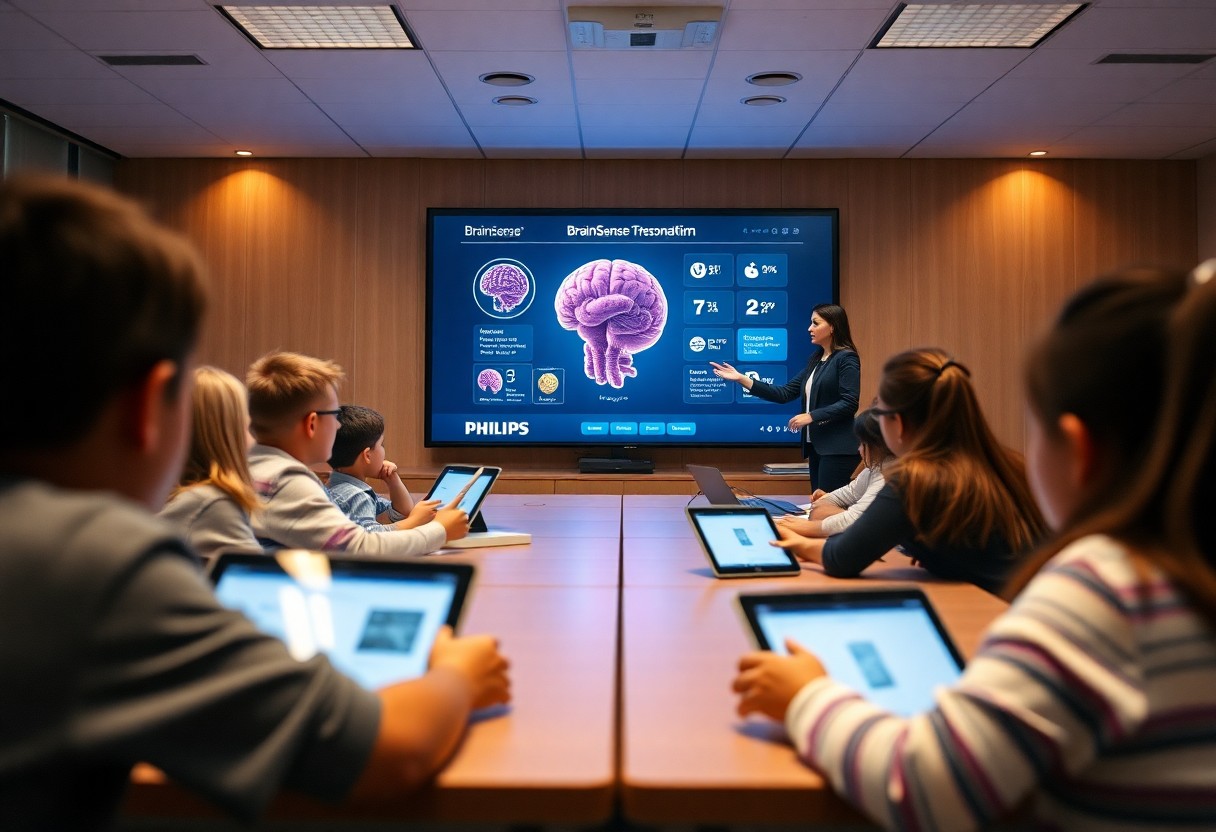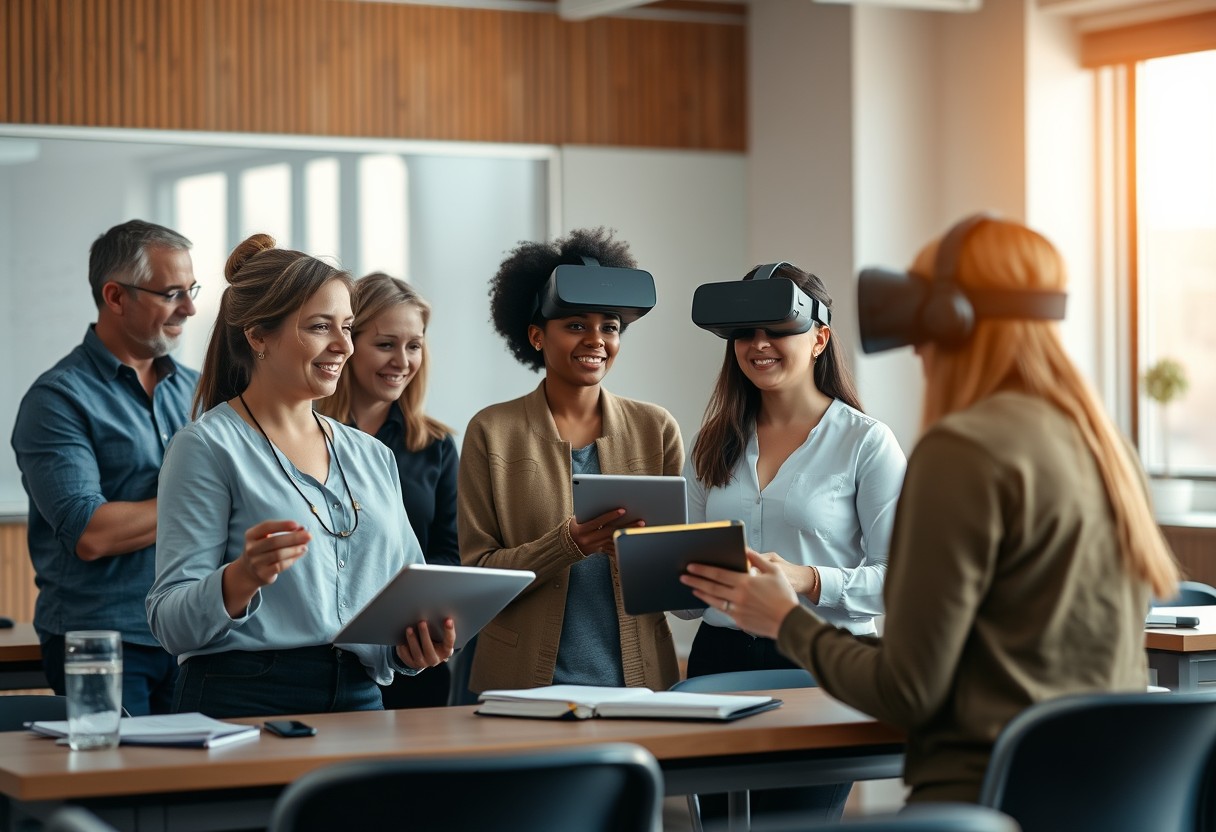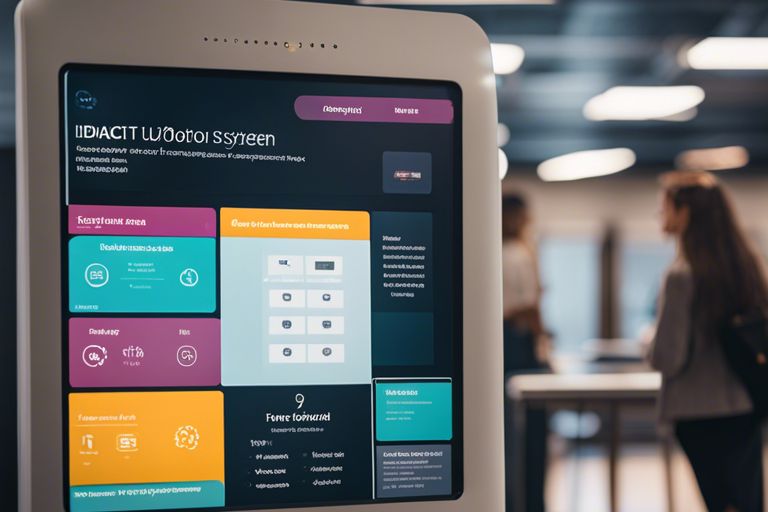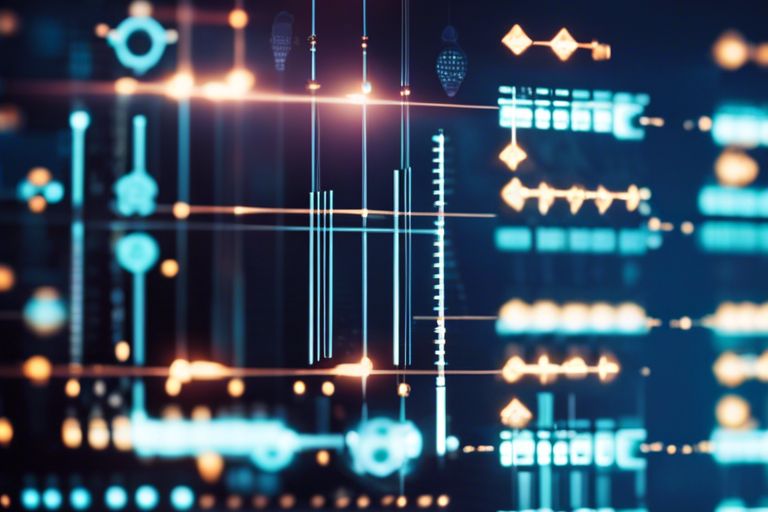Personalization is at the heart of modern educational technology innovations, and Philips’ BrainSense™ Personalization Platform exemplifies this trend. This platform empowers you to optimize your learning experience by integrating advanced neuroscientific insights with personalized educational strategies. By understanding your unique needs and preferences, BrainSense™ offers tailored pathways that enhance engagement and retention of information. In this blog post, you will discover how these transformative steps can elevate your educational journey and enhance your overall learning outcomes.
Key Takeaways:
- Personalization: Philips’ BrainSense™ platform focuses on customizing educational experiences to meet individual learning needs.
- Data-Driven Insights: The platform utilizes advanced analytics to gather insights into learner behaviors, enhancing instructional strategies.
- Enhanced Engagement: By leveraging real-time feedback, the technology increases student engagement and motivation in their learning journeys.
- Collaborative Learning: BrainSense™ promotes collaboration among educators and students, fostering a community-driven learning environment.
- Adaptive Learning: The system adapitates content delivery based on user interactions, ensuring optimal learning pathways are explored.

The Need for Innovation in Educational Technology
Before diving deeper into the transformation of educational technology, it is imperative to understand the historical context that has shaped its evolution. In the early days of education, tools such as chalkboards and textbooks were the primary resources for disseminating knowledge. It was a time when the teacher’s role was largely authoritarian, and learning often occurred in a one-size-fits-all manner. As societies progressed, so did the understanding that education should evolve, leading to the first waves of technology integration, such as overhead projectors and audio-visual aids, which sought to enhance the learning experience.
Historical Context of Educational Technology
Against this backdrop of traditional methods, each technological advancement sparked further innovations, contributing to a more interactive and engaging learning environment. The rise of computers and the internet in the late 20th century marked a significant turning point. Suddenly, students had access to an infinite pool of information and, with it, new ways to learn and explore subjects in detail. However, while these advancements expanded resources and opportunities, they also highlighted disparities in accessibility and engagement that traditional methods could not address.
Challenges Facing Traditional Educational Methods
Above all, the challenges posed by traditional educational methods persist in a digital age where innovation is not only necessary but imperative. You might find that conventional teaching often caters to a homogeneous group rather than addressing diverse learning needs. This lack of adaptability can lead to disengagement among students who require different approaches to absorb information. Traditional models frequently neglect to account for individual learning preferences, ultimately hindering student achievement and satisfaction.
Another significant concern is the pace at which information is now presented. With constant advancements in technology and the rapid evolution of knowledge, traditional methods struggle to keep up. You may have observed that curricula can be slow to adapt, leaving students ill-prepared for real-world applications. As a result, the gap between what is taught in the classroom and the skills required in the workforce continues to widen.
Importance of Personalization in Learning
Importance lies at the heart of effective education, where personalized learning can bridge the gaps left by traditional methods. By tailoring educational experiences to suit individual needs, you can engage students on a deeper level. The goal is to create learning paths that resonate with each student, fostering a sense of ownership and enhancing motivation. Personalization not only accommodates varying learning styles but also helps identify and address gaps in understanding at an early stage.
It is imperative to note that the move towards personalization goes beyond mere preference; it is a strategy to enhance retention and application of knowledge. You should also acknowledge that a personalized approach allows educators to monitor progress more effectively and modify instructional strategies in real time. This adaptability ensures that every student has access to a learning experience that is not only relevant but also empowering.
Overview of Philips’ BrainSense™ Personalization Platform
If you are seeking to enhance educational outcomes through the latest technology, it’s important to understand the potential of Philips’ BrainSense™ Personalization Platform. This innovative tool is designed to tailor learning experiences to individual needs, thereby fostering deeper engagement and improved comprehension. By utilizing advanced neuroscience research, BrainSense™ provides educators with critical insights into how students learn best, enabling a more personalized approach to education.
What is BrainSense™?
After years of development, the BrainSense™ Personalization Platform has emerged as a game-changer in educational technology. By leveraging real-time data and analytics, it assesses the cognitive and emotional states of learners, allowing for adjustments in teaching strategies and materials. This dynamic feedback mechanism creates a more responsive educational environment that adapts to your needs as a student or educator, enhancing the overall learning experience.
Core Features of the Platform
One of the standout aspects of the BrainSense™ platform is its integration of multiple features aimed at promoting personalized learning. These include cognitive assessments that measure various learning styles and emotional engagement levels. Furthermore, the platform offers actionable insights and recommendations based on these assessments, allowing you to fine-tune educational approaches for maximum effectiveness.
Personalization is at the heart of the BrainSense™ platform, ensuring that every user’s unique cognitive profile is taken into account. This sophistication empowers educators and learners to pinpoint strengths and areas for growth, allowing for targeted interventions that lead to more fruitful outcomes. By embracing this technology, you can maximize the potential within your learning environment.
Integration with Existing Educational Tools
Behind the scenes, BrainSense™ is designed with compatibility in mind, allowing seamless integration with your existing educational tools and platforms. This means that you can leverage your current systems while enhancing them with the advanced capabilities of BrainSense™. It facilitates not only a smooth transition but also the ability to enrich existing curricula with personalized elements that foster deeper learning experiences.
Integration is a vital feature of Philips’ BrainSense™ Personalization Platform. It ensures that you can access a comprehensive suite of tools without feeling overwhelmed by the changes. By connecting with platforms already in use, such as learning management systems or instructional software, you can adopt this innovative technology without disrupting your current workflow. As a result, you gain access to enriched learning experiences that blend traditional methods with future-forward personalization.
Transformative Steps in Personalization
Once again, educational technology is evolving, and Philips’ BrainSense™ Personalization Platform is at the forefront of this evolution. By providing tools that allow for deeper insights into learner behavior and preferences, it enables educators and institutions to create adaptive learning experiences tailored specifically to individual needs. The importance of personalization in education cannot be understated, as it can significantly influence student outcomes and overall satisfaction with the learning process.
Data-Driven Decision Making
Behind every successful personalized learning experience lies effective data-driven decision making. Utilizing sophisticated algorithms and analytics, the BrainSense™ platform aggregates vast amounts of data related to student performance, engagement levels, and even emotional responses. By interpreting this data, you can make informed choices that guide the development of personalized strategies, enhancing the effectiveness of your educational programs.
This process allows you to identify patterns and trends that inform curriculum design, teaching methods, and resource allocation. As a result, you are better equipped to address the diverse needs of your learners, ultimately fostering an environment that promotes success for all students.
Adaptive Learning Pathways
Transformative educational experiences are most effective when they incorporate adaptive learning pathways. This concept revolves around the flexibility to adjust learning paths based on individual students’ strengths, weaknesses, and interests. With the BrainSense™ platform, you can leverage real-time feedback to tailor content delivery, ensuring that every learner progresses at their own pace. This personalized approach helps to maximize learning potential and promotes retention of information.
Learning should always be a dynamic process, and adaptive learning pathways aim to fulfill this objective. By creating pathways that adapt to your students’ needs, you can facilitate more meaningful interactions with the content, enabling them to grasp complex concepts more comfortably. Furthermore, it allows for methodologies that cater to varying learning styles, enriching the overall educational experience.
Enhancing Student Engagement and Motivation
Decision-making in educational settings often requires a keen focus on enhancing student engagement and motivation. Philips’ BrainSense™ platform provides valuable insights into what captivates your students’ attention and keeps them invested in their learning journey. By understanding these motivators, you can design lessons that resonate more deeply with your students, driving sustained interest and participation.
Moreover, engagement is not solely about content; it’s about building a relationship with students. Creating opportunities for them to express their interests and participate in decision-making processes related to their learning can foster a more engaged classroom environment. When students feel that their preferences matter, they are more likely to take ownership of their educational experiences.
Student engagement ultimately leads to improved academic outcomes. By continuously adapting to the needs and interests of your learners, you can create a more motivating atmosphere that encourages exploration, inquiry, and a desire for knowledge. This approach not only aids in retention but also empowers your students to become active participants in their learning journey.
Case Studies on Implementation
Many educational institutions have embraced Philips’ BrainSense™ Personalization Platform, leading to transformative changes in their learning environments. Below, you will find a detailed list of case studies showcasing the positive impact of this innovative technology:
- Galaxy High School: Achieved a 30% increase in student engagement and a 20% improvement in test scores after implementing BrainSense™.
- Lakeside College: Reported a 40% reduction in dropout rates and improved overall satisfaction among students and faculty after nine months of use.
- Pinehill University: Noted a 50% increase in course completion rates by leveraging personalized learning paths that BrainSense™ offers.
- Oakridge Academy: Experienced a 35% improvement in student feedback scores about their learning experience post-implementation.
- Maplewood Institute: Documented a substantial 25% enhancement in collaborative learning efforts, thanks to tailored group dynamics facilitated by the platform.
Success Stories from Educational Institutions
An increasing number of institutions are successfully implementing the BrainSense™ platform, leading to significant educational advancements. For instance, Galaxy High School’s experience reflects a transformation in student engagement levels. By leveraging the platform’s ability to personalize learning experiences, educators have seen students taking an active role in their educational journeys, fostering a dynamic learning atmosphere.
Another noteworthy success is Lakeside College, where the integration of the BrainSense™ system resulted in remarkable outcomes. The reduced dropout rates indicate that personalized learning assistance has helped students remain connected and invested in their education, ultimately leading to higher retention and success rates. These success stories exemplify how educational technology innovation can reshape the learning landscape to support both students and educators better.
Comparative Analysis of Pre- and Post-Implementation Outcomes
Stories from educational institutions that utilized the BrainSense™ platform reveal a compelling narrative of transformation. The comparative analysis of pre- and post-implementation outcomes demonstrates the technology’s effectiveness in enhancing various aspects of the educational experience.
Comparative Analysis of Outcomes
| Outcome | Percentage Change |
|---|---|
| Student Engagement | +30% |
| Test Scores | +20% |
| Course Completion Rates | +50% |
| Dropout Rates | -40% |
| Feedback Scores | +35% |
Further analysis shows that implementing the BrainSense™ platform can drastically alter academic landscapes. Educational institutions have experienced profound changes in metrics associated with student performance and satisfaction. This highlights how crucial personalization in education is for overall performance and retention, enabling you, the educator, to tailor learning in ways that align with unique student profiles.
Feedback from Educators and Students
At multiple institutions, the feedback from educators and students regarding the BrainSense™ platform has been overwhelmingly positive. Most educators noted that the platform allows them to understand their students’ specific learning styles better, leading to more effective teaching strategies. Students, on the other hand, reported feeling more engaged and motivated, emphasizing how personalized learning transformed their educational experience.
Additionally, the platform encourages collaborative learning among peers, which many students find beneficial. Connections with their classmates facilitate deeper discussions and shared understanding, ultimately enhancing the learning process. However, it is crucial to recognize the ongoing adjustments that both educators and students have had to make in adapting to this new technology.
But there are occasional challenges noted in the transition phase. Educators seemed to require time to fully adapt to the personalization system and effectively utilize its features. Furthermore, some students initially faced difficulties in adapting to the bespoke learning pathways. Overall, the ongoing dialogue and feedback loop among users ensure continuous improvements, making the platform even more effective in providing personalized educational experiences.
Future Trends in Educational Technology
For educators and institutions alike, understanding future trends in educational technology can significantly enhance teaching methods and learning outcomes. As these innovations evolve, they will allow you to tailor educational experiences that not only engage students but also cater to their individual needs. This is especially crucial as the digital landscape continues to change, integrating advanced technologies that redefine the classroom environment.
The Role of Artificial Intelligence in Education
Before delving into the specifics of AI in education, it’s important to acknowledge its transformative potential. Artificial Intelligence can automate administrative tasks, allowing you to focus more on what truly matters — personalized instruction and interaction with your students. With AI, you can analyze a wealth of data to understand student performance trends and adapt your teaching strategies accordingly, creating a more effective and engaging learning experience.
Furthermore, AI-driven tools such as virtual tutors and chatbots can support your students beyond the classroom. These tools can provide immediate feedback and assistance, ensuring that learning is a continuous process and not limited to specific time frames. This technology empowers you to become a facilitator of learning, guiding your students in their educational journeys.
Predictions for Future Innovations
Beside the advancements in artificial intelligence, you can expect several innovations to shape the educational landscape in the coming years. Increased accessibility through mobile learning platforms will make education available to a broader audience, allowing you to reach learners who may have been excluded from traditional education systems. Moreover, the rise of immersive learning experiences, such as augmented reality (AR) and virtual reality (VR), will revolutionize how you engage with your students, making learning more interactive and enjoyable.
Even as you look ahead, consider how innovation will create a more interconnected and collaborative educational ecosystem. The integration of blockchain technology could offer secure methods for credit verification and record-keeping, while advancements in adaptive learning platforms will refine how you monitor and respond to individual student needs. This convergence of technologies promises to create a learning environment that is not only more efficient but also more aligned with the students’ own learning processes.
Long-Term Impacts on Learning Environments
Below the surface of immediate technological gains lies the potential for long-term impacts on learning environments. As you incorporate innovative tools and approaches, you may notice a shift in the dynamics of the classroom. With a focus on personalized and collaborative learning, students will likely become more engaged and motivated, fostering a culture of academic curiosity and resilience.
Also, as educational technology continues to evolve, expect a blend of physical and digital spaces that reshapes how learning occurs. Classrooms will transform into more flexible environments where technology not only supplements but enhances the learning experience. This will encourage diverse teaching methodologies and allow you to create a more stimulating and interactive atmosphere for your students.
Challenges and Considerations
Your journey into educational technology innovation through Philips’ BrainSense™ Personalization Platform presents numerous opportunities, but it also comes with a set of challenges that warrant your attention. A deeper understanding of these challenges will empower you to navigate potential pitfalls while maximizing the platform’s benefits. Among these are ethical implications concerning data use, technical barriers to implementation, and resistance to change among stakeholders.
Ethical Implications of Data Use
For every innovation in technology, particularly in education, you must reflect on the ethical ramifications surrounding data usage. The BrainSense™ platform collects various types of student data to personalize learning experiences. This raises questions about privacy, consent, and data ownership. As you probe into personalized education, it’s critical that you ensure transparency regarding how data is collected, used, and protected. Students and their guardians need to feel secure in sharing sensitive information, reinforcing their trust in the educational environment.
For you, adhering to ethical standards ultimately plays a significant role in the success of the platform. By establishing clear guidelines for data use and fostering a culture of accountability, you can help create a system that values student privacy while gaining insights that enhance educational outcomes. It is your responsibility to advocate for ethical practices when employing technology in educational settings.
Technical Barriers to Implementation
Data integration can pose considerable challenges when implementing Philips’ BrainSense™. Your existing educational framework must align with the technological requirements of this personalized platform. Compatibility issues may arise with legacy systems, potentially complicating data exchange and hinder the seamless flow of information necessary for effective personalization.
Implementation of the BrainSense™ Personalization Platform requires not just software adjustments but potentially hardware upgrades as well. If you encounter outdated technology resources in your institution, you may need significant investments in infrastructure to facilitate the smooth functioning of new tools. These enhancements, while beneficial, can be overwhelming and require careful planning to avoid disruptions in the educational process.
Resistance to Change Among Stakeholders
Across the educational landscape, change often meets with resistance from diverse stakeholders, including educators, administrators, and even students. This reluctance may stem from fear of the unknown, comfort with the status quo, or concerns about new technology’s impact on traditional teaching methods. As you strive to implement the BrainSense™ platform, it’s necessary to collectively address these concerns and engage all stakeholders in the transition process.
Considering that education is deeply rooted in established norms, you might find it beneficial to facilitate open communication channels. Encourage dialogue around the advantages of personalized education and provide training sessions to empower your stakeholders. By showcasing the positive outcomes of the BrainSense™ platform, you can gradually foster acceptance and enthusiasm for this innovative approach to learning.
To Wrap Up
So, as you explore educational technology innovation, Philips’ BrainSense™ Personalization Platform provides an exceptional opportunity for you to enhance learning experiences. By integrating tailored educational approaches based on neuroscience and individual learning patterns, you can empower not only yourself but also your students in achieving better educational outcomes. This platform helps you make informed decisions tailored to specific needs, promoting a more engaging and effective learning environment.
Additionally, as you immerse yourself in this transformative technology, you will find that leveraging data-driven insights can improve not only personal learning effectiveness but also facilitate collaboration among educators. This progressive approach fosters an adaptive learning ecosystem where you can contribute to developing strategies that resonate with the diverse learning requirements of your audience. Embracing Philips’ BrainSense™ platform will position you at the forefront of educational innovation, preparing you to meet the dynamic demands of the future of education.
FAQ
Q: What is Philips’ BrainSense™ Personalization Platform?
A: Philips’ BrainSense™ Personalization Platform is an innovative educational technology tool designed to cater to individual learning needs. It utilizes advanced data analytics and AI-driven algorithms to assess students’ cognitive and emotional status, thereby providing personalized learning experiences that enhance engagement, retention, and overall academic performance.
Q: How does BrainSense™ enhance the learning experience for students?
A: The BrainSense™ platform enhances learning experiences by offering tailored content and adaptive learning paths based on real-time feedback from students. By analyzing factors like attention levels, stress indicators, and emotional responses, the platform can suggest customized resources and activities that align with each student’s specific needs, leading to more effective learning outcomes.
Q: What role does data play in the BrainSense™ Personalization Platform?
A: Data plays a central role in the BrainSense™ platform by providing the foundation for personalization. It collects and analyzes various data points, including learning style preferences, cognitive performance metrics, and emotional reactions. This information is used to create a comprehensive profile for each learner, which informs the platform’s recommendations for educational resources and strategies tailored to optimize their learning experience.
Q: Is the BrainSense™ platform suitable for all educational settings?
A: Yes, the BrainSense™ platform is designed to be versatile and can be implemented across various educational settings, including K-12 schools, higher education institutions, and corporate training environments. Its adaptive capabilities allow it to cater to diverse learner populations and educational objectives, making it a valuable tool for educators aiming to enhance engagement and effectiveness in their programs.
Q: How can educators benefit from using the BrainSense™ Personalization Platform?
A: Educators can benefit from the BrainSense™ platform by gaining deeper insights into their students’ learning behaviors and preferences. This understanding enables them to deliver more effective instruction and allocate resources efficiently. Moreover, the platform provides regular progress reports and analytics that help teachers assess the impact of their teaching strategies, leading to informed decisions that can improve instructional practices and student outcomes.




